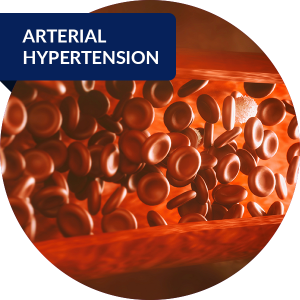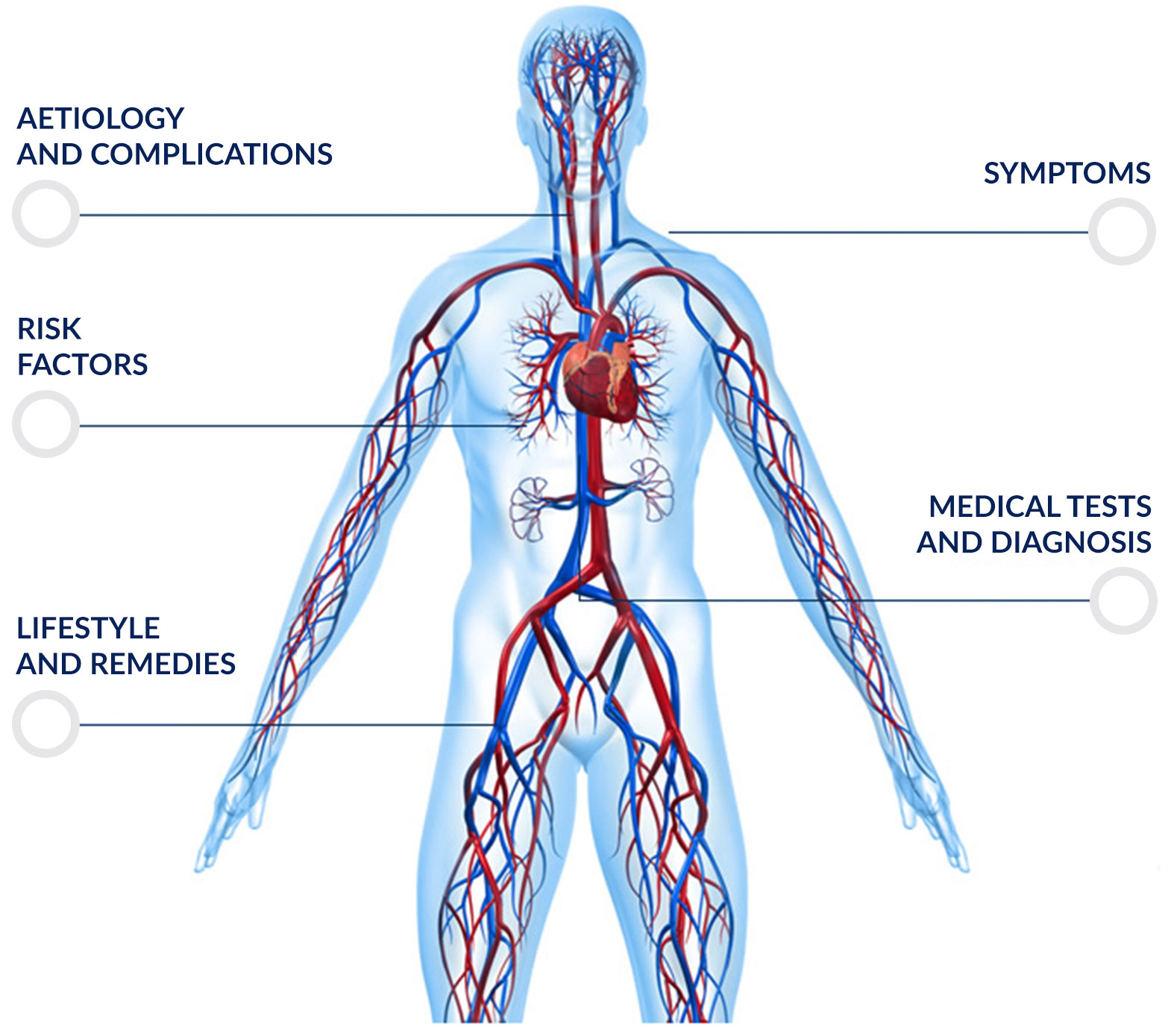
There are two types of hypertension:
- primary (essential) hypertension: it accounts for over 95% of all cases of hypertension. It tends to develop gradually over the years; it affects adults and it has no known cause.
- Secondary hypertension: this form is relatively rare; sometimes, it can disappear when its cause is eliminated. People under 20 or above 50 years old are usually affected. Secondary hypertension usually appears all of a sudden, causing higher pressure values than those of primary hypertension. It can be caused by multiple conditions, such as: renal diseases, adrenal gland cancer, birth defects affecting blood vessels, medication (birth control pill, decongestants, painkillers), and drugs (cocaine, amphetamine).
Hypertension is more common among adults, although children can also be affected because of kidney or heart-related conditions. Unhealthy life habits, such as an unhealthy diet and a lack of exercise, can contribute to the development of hypertension.
Select to learn more

Aetiology and complications
There are two types of hypertension:
- Primary (essential) hypertension: in most cases, there is no obvious cause. This type of hypertension tends to develop gradually over many years.
- Secondary hypertension: some people may have high blood pressure due to an underlying condition. This form of hypertension usually appears all of a sudden, and it causes higher pressure values than those of primary hypertension. Secondary hypertension can be caused by a number of conditions or medications, including: kidney problems, adrenal gland tumours, congenital conditions affecting the blood vessels, certain medications such as the contraceptive pill, decongestants, painkillers, and illegal drugs such as cocaine and amphetamines.
Artery walls are made of a semi-flexible tissue that stretches like an elastic when the heart pumps blood through the arteries. The higher the strength of the pumping, the more arteries will stretch to allow the blood to flow easily. Over time, if the blood flow is often too strong, the tissue of the artery walls extends consistently beyond its physiological limit. This causes problems in different ways.
Vascular system weakness: excessive stretching of blood vessels walls weakens them; if the composition of the vascular walls changes, these can break and cause the blood to leak, which is what happens during strokes or aneurysm ruptures.
Vascular scarring: excessive tension can cause small tears in the blood vessels, which leave scars on artery walls. These micro-lacerations and the scar tissue become networks capable of capturing circulating cells, cholesterol and other substances. This contributes to the formation of atheromatous plaques on artery walls.
Increased risk of blood clots: when blood comes into contact with altered artery walls, it can form blood clots. These clots can grow to the point where they block the lumen of the vessel, or they can detach and obstruct smaller vessels downstream, resulting in an ischemic area due to the lack of blood flow.
Increased formation of atherosclerosis plaques: cholesterol and and plaque buildup in the arteries can partially or completely block the lumen of the blood vessel, preventing blood from flowing through it As this happens, pressure on the rest of the cardiovascular system increases, forcing the heart to work harder to supply blood to the body.
Symptoms
Most people with high blood pressure have no signs or symptoms, even if blood pressure readings reach dangerously high levels. Although some people with early-sage high blood pressure may have acute headaches, vertigo or nosebleeds, these signs and symptoms usually don’t occur until hypertension has reached a severe or chronic stage.
Risk factors
High blood pressure has several risk factors, including:
Age. The risk of hypertension increases as you age. The risk of hypertension is more common in middle-aged men. Women are more likely to develop hypertension after the menopause.
Ethnicity. High blood pressure is particularly common among people of African heritage, often developing at an earlier age than it does in whites. Serious complications, such as stroke, heart attack and kidney failure, also are more common in people of African heritage.
Family history. Hypertension is more common in children of people with high blood pressure.
Being overweight or obese. The more you weigh, the more blood you need to supply oxygen and nutrients to your tissues. As the volume of blood circulated through your blood vessels increases, so does the pressure on your artery walls.
Lack of exercise. People who are inactive tend to have higher basal heart rates. The higher your basal heart rate, the harder your heart must work with each contraction and the stronger the force on your arteries
Use of tobacco. Not only does smoking or chewing tobacco immediately raise your blood pressure temporarily, but the chemicals in tobacco can damage the lining of your artery walls causing atherosclerosis.
Excessive consumption of salt (sodium) Too much sodium in your diet can cause your body to retain fluid, which increases blood pressure.
Lack of vitamin D It is still uncertain whether a lack of vitamin D can cause hypertension. Vitamin D influences an enzyme produced by the kidneys that controls blood pressure.
Alcohol abuse Over time, heavy drinking can damage the heart and increase blood pressure.
Stress High levels of stress can lead to a temporary but dramatic increase in blood pressure.
Some chronic conditions Certain chronic conditions also may increase your risk of high blood pressure, such as high cholesterol, diabetes, kidney disease and sleep apnoea.
Although hypertension is more common among adults, children can also be affected due to kidney or heart-related conditions. But for a growing number of kids, poor lifestyle habits, such as an unhealthy diet, obesity and lack of exercise, contribute to the development of hypertension.
Medical tests and diagnosis
Blood pressure is measured using an inflatable arm cuff around your arm and a pressure-measuring gauge. A blood pressure reading, given in millimetres of mercury (mm Hg), has two numbers; the first number measures the pressure in your arteries when your heart contracts (maximum or systolic pressure); the second number measures the pressure in your arteries when the heart is relaxed (minimum or diastolic pressure).
Blood pressure measurements fall into four general categories:
Normal blood pressure. Normal pressure values are usually around 120/80 mm/Hg. However, some doctors recommend 115/75 mmHg as a target pressure. When blood pressure rises over 115/75 mmHg, the risk of cardiovascular diseases starts to increase.
Pre-hypertension. Systolic pressure value consistently ranging from 120 to 129 mm Hg and a diastolic pressure between 80 and 89 mm Hg are signs of pre-hypertension. Pre-hypertension tends to get worse with time.
Stage 1 hypertension. Systolic pressure value consistently ranging from 140 to 159 mm Hg and a diastolic pressure between 90 and 99 mm Hg are signs of stage 1 hypertension.
Stage 2 hypertension. A systolic pressure consistently around 160 mm Hg or higher or a diastolic pressure equal or higher than 100 mm Hg indicate more severe hypertension (stage 2).
Both numbers in a blood pressure reading are important, but after age 50, the systolic reading is even more significant. Isolated systolic hypertension, in which the diastolic pressure is normal but systolic pressure is high, is the most common type of hypertension in adults over the age of 50.
Before diagnosing hypertension, your doctor will need 2 or 3 abnormal blood pressure measurements taken at two or more separate appointments. This is because blood pressure normally varies throughout the day, and sometimes it may be particularly elevated during visits to the doctor, due to a condition called white coat hypertension. Your doctor may ask you to record your blood pressure at home or at work to provide additional information.
For any type of hypertension, your doctor can recommend routine tests, such as a urine test (urine analysis), blood tests and electrocardiogram (ECG), a test measuring the heart’s electrical activity. Your doctor may suggest further tests, such as a cholesterol dosage, to check for ather signs of heart disease.
Taking your blood pressure at home An important way to check if your blood pressure treatment is working or to diagnose worsening high blood pressure, is to monitor your blood pressure at home. Home blood pressure monitors are widely available and inexpensive, and you don’t need a prescription to buy one.
Lifestyle and remedies
Changing your lifestyle can help you limit and prevent hypertension.
Eat a healthy diet. Eating fruit, vegetables, wholewheat cereal and low-fat dairy products as the main component of your diet reduces the risk of diet-induced hypertension (DASH) Potassium-rich foods can help prevent and limit high blood pressure. It is generally advisable to reduce the consumption of fats, particularly saturated fats.
Reduce the salt in your diet. A sodium intake of 1,500 mg per day is ideal for most people over the age of 50, people of all ages that are of African heritage, or people suffering with hypertension, diabetes, or a chronic renal disease. In all other cases, a sodium intake below 2,300 mg is advisable. As well as checking the amount of salt used in condiments, you should also pay attention to how much salt is contained in ready meals.
Maintain a healthy weight. If you are overweight, losing as little as 2-3 kg can help lower your blood pressure.
Increase physical activity. Regular physical activity can help lower your blood pressure and keep your weight under control.
Limit alcohol consumption. Even if you’re healthy, drinking alcohol can raise your blood pressure. If you choose to drink alcohol, do so in moderation: up to one glass a day for women and people over the age of 65, and two glasses a day for men.
Do not smoke. Tobacco can injure blood vessel walls and speed up the process of buildup of plaque in the arteries.
Manage stress. Reduce stress as much as possible.




